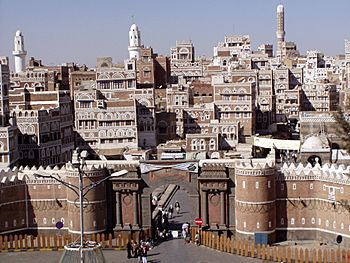Yemenite architecture facts for kids

Yemenite architecture is a very special way of building found in the country of Yemen. It's known for its unique look and how it uses local materials. This style has been around for a very long time, from before Islam came to Yemen all the way up to today.
Contents
Yemenite Architecture: Building with History
Yemenite architecture is a distinct style of building. It shows how people in Yemen have built their homes and cities for thousands of years. This style is famous for its tall, tower-like buildings. It also uses special materials like mud bricks.
What Makes Yemenite Buildings Special?
Many Yemenite buildings are made from mud bricks. These bricks are created from mud, straw, and water. They are then dried in the sun. This makes them strong and good for keeping homes cool in hot weather.
Another cool feature is the tall, tower-like shape of many homes. These buildings can be several stories high. They often have beautiful patterns on their outside walls. Sometimes, large stones are also used in the construction. These stones are carefully placed between the mud brick sections.
A Look at History: From Ancient Times to Today
Yemenite architecture has a long history. It started even before the religion of Islam spread in the region. Over time, the style changed and grew. When Islam arrived, it influenced how buildings were designed. Many important buildings from that time show this unique blend of old traditions and new ideas.
The design of buildings where Islam first began to spread in Yemen is very important. These structures show how the style adapted. They also highlight the rich history of the area.
Where Can You See This Architecture?
You can see Yemenite architecture mainly in Yemen itself. Cities like Sana'a are famous for their old buildings. The Old City of Sana'a is even a World Heritage Site. This means it's recognized as very important globally.
You might also find similar building styles outside Yemen. Some villages in southern Saudi Arabia are close to the Yemen border. These villages sometimes have buildings that look a lot like those in Yemen. This shows how building traditions can spread between neighboring areas.

